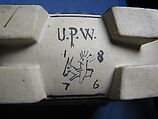Pilgrim vase
Manufacturer Union Porcelain Works American
Designer Karl L. H. Müller American
Decorator Karl L. H. Müller American
The Philadelphia Centennial Exhibition in 1876 was a critical catalyst for the development of the American Art Pottery movement. In celebration of the country's hundred-year history, the enormous fair--for which preparations began in 1871--was designed to demonstrate America's technological and artistic progress in the years since gaining its independence. Ceramics played a critical role at the fair, providing an anthology of world ceramics, the repercussions of which were felt for decades. American ceramics manufacturers saw the Centennial Exhibition as an opportunity to elevate the aesthetic and technical quality of their wares and to seize a greater part of the burgeoning ceramics market from foreign rivals. For the first time, the fair would provide a major international showcase for their products; it signaled an increasing emphasis on the artistic aspects of ceramic production. Among the important American potteries exhibiting special wares at the Centennial was the Union Porcelain Works, located in the Greenpoint section of Brooklyn, New York, and at the time one of the country's largest porcelain manufactories. Until then its production had been limited to table services, utilitarian industrial wares, and hardware trimmings, such as doorknobs and keyhole covers. Owner Thomas Carl Smith enlisted the help of German-born sculptor Karl L. H. Muller to design some of the most extraordinary works destined for the expositions; the results were intended to be both artistic and "American" Resurrecting styles from the past, the firm sought to revitalize them in adventurous ways.
This pilgrim flask designed by Muller, demonstrates the prevailing interest in contemporary English Reform design, characterized by a simplification of natural forms into linear, two-dimensional ornament as promulgated by British designers such as Charles Locke Eastlake and Christopher Dresser, whose publications were widely known in the United States The flat-sided form--highly suitable for painted decoration--is one favored by British and American ceramic artists working in the late 1870s and 1880s.
It features a scene of two winged children, one with a donkey headdress and the other dressed as a thistle plant. The overall style of the decoration is aligned with then-contemporary English ideals, specifically the literary-themed depictions by J. Mohr Smith for the Mintons pottery in Staffordshire, England. Indeed Muller's vase closely resembles one by Mohr Smith in both form and style of decoration. While Moyer Smith's design specifically illustrate fables by Aesop and Shakespeare, Muller's imagery does not seem to be derived from either. The closest Aesop tale is the Ass and the Thistle; a reference to Shakespeare might be seen in the left-hand figure, possible the character of Bottom in A Midsummer Night's Dream. The subject was not necessarily understood even in its period--an 1876 trade journal commented that "a pair of curiously-shaped jugs are comically illustrated with "the donkey and the thistle." Muller's design evidently enjoyed some popularity since the Union Porcelain works employed it as well for the central image on a polychrome decorated porcelain plate.
The vase bears Muller's pictograph monogram of a man on a mule, his initials, and the date 1876.
This vase is from the Robert A. Ellison Jr. Collection of American art pottery donated to the Metropolitan Museum in 2017 and 2018. The works in the collection date from the mid-1870s through the 1950s. Together they comprise one of the most comprehensive and important assemblages of this material known.
Due to rights restrictions, this image cannot be enlarged, viewed at full screen, or downloaded.


